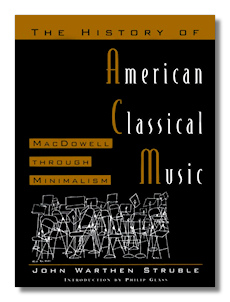
The Internet's Premier Classical Music Source
Related Links
-
Introduction
Acoustics
Ballet
Biographies
Chamber Music
Composers & Composition
Conducting
Criticism & Commentary
Discographies & CD Guides
Fiction
History
Humor
Illustrations & Photos
Instrumental
Lieder
Music Appreciation
Music Education
Music Industry
Music and the Mind
Opera
Orchestration
Reference Works
Scores
Thematic Indices
Theory & Analysis
Vocal Technique
Search Amazon
Recommended Links
Site News
 Book Review
Book Review
The History Of American Classical Music

MacDowell Through Minimalism
John Warthen Struble
NY: Facts on File, 1995. 444p
ISBN: 081602927X
The arrangement and proportional emphases of a historical survey like this inevitably reveals much about an author's perspectives and preferences. In comparison with another recent book, Lyle Gann's American Music in the Twentieth Century (Schirmer, 1997), which focuses very heavily on experimental innovators, Struble attempts to give a more even-handed consideration to three main currents: the Americanist, the academic and the experimental. His sympathies lean toward the first and third of these, but he succeeds in dealing fairly, if not equally, with all the composers he discusses. His approach is mainly a composer by composer treatment, though he does of course place them in a stylistic framework. His explanations of stylistic developments is clear, intelligible and concise. He does not use musical examples (unlike Gann) and there is more biographical than stylistic content, on balance. Not counting the introductory and concluding sections, he groups composers by period or by style – he surely struggled with this – in a dozen chapters. Ives, Gershwin and Cage get a separate chapter each, which tells you something about his priorities.
This survey of American musical history might have been subtitled simply with the dates 1620-1993, because Struble opens with a chapter called "Forerunners," outlining seven distinct, and old, regional styles that had some influence on later developments. MacDowell shares a chapter on the "Second new England School" (the first being Billings and others) with Paine, Chadwick, Beach and Parker. Early 20th Century composers such as Farwell, Carpenter, Deems Taylor, John J. Becker (to whom Ives left a bequest), Ornstein (whom I don't know but now think I should), and several even more obscure, are discussed along with Griffes, whom Struble considers the best of the lot. Copland, Thomson and Harris enjoy two chapters – before and after 1933 – with briefer treatments of Antheil, Blitzstein, Riegger, Toch, Thompson and William Grant Still. Sandwiched into the 1933 entr'acte, so to speak, is an extended account, neutral in tone, of the "Rise of Musical Academia." which considers composers as diverse as Hanson, Bloch, Sessions, Piston, Schuman, Babbitt, Perle and Luening. Warthen reveals Babbitt's lifelong interest in popular music, for those who think of him only in very different terms.
Next, the period from the Forties to the Sixties is again given a mixed- bag approach, introducing Barber, Menotti, Carter, Bernstein and, more briefly, Ross Lee Finney, Crumb, Foss, Creston, Gould, Diamond, Hovhanness, Persichetti, Kirchner, Schuller, the "strikingly original" film composer Bernard Herrman, and a name completely unfamiliar to me, John LaMontaine, said to have written a very lyrical piano concerto. (No mention of Harold Shapero.)
The Sixties avant-garde chapter has chronology trouble again, because it begins with Ruggles, Cowell and Varèse, who were much earlier figures, followed by Partch, Nancarrow, Dane Rudhyar and Lou Harrison. In connection with Cage and the aleatoric "revolution," Struble writes about Feldman, Earle Brown and Pauline Oliveros, whose music he clearly likes. Here he introduces the sugggestion that it may be perfectly all right for a composer to write only for a local audience; the instruments of Partch, for instance, are unique objects.
When he gets to post-modernism and minimalism, Struble reveals his lack of regret for the passing of serialism. He does not attack it, but he does seem to celebrate the liberation from it of those he considers next. No one he discusses, except John Adams, is under the age of sixty, which is perhaps disappointing, though this is a history, after all. Rochberg, Del Tredici, Corigliano, Druckman, Stephen Albert, and Bolcom (the best of these, in Struble's view) are his choices for discussion. The minimalism chapter discusses all the usual suspects along with their differences.
Finally, in conclusion, Struble lays out alternative futures for classical music in America, along with a discussion of factors such as the enormous proliferation of composers, self-censorship by composers faced with funding and grant guidelines, "the double-edged sword" of recording and broadcasting developments, and audience concerns.
Aside from an occasional quibble or even an brow-raising remark or two by Struble, which I see no need to draw attention to, and aside from the inevitable reservations about emphasis on this composer rather than that, this is a book that looks back on historical musical developments with the kind of perspective I find it comfortable to share. Recommended.
Copyright © 1999 by R. James Tobin


















